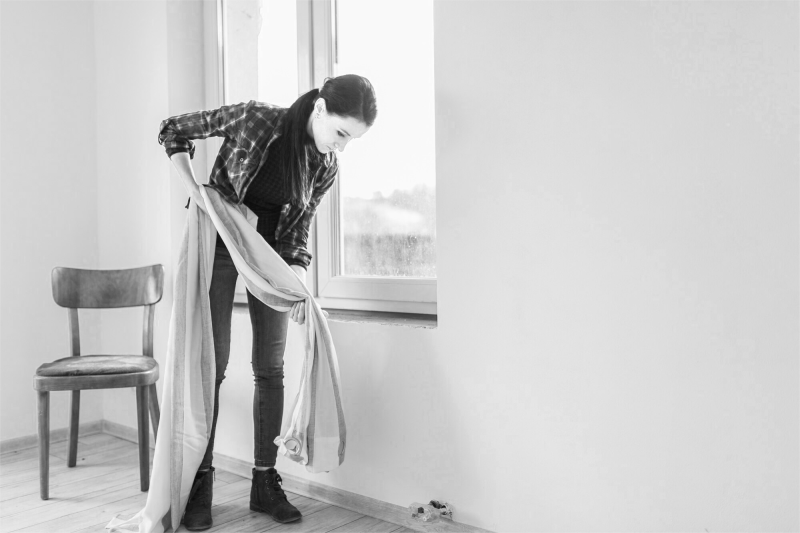Have you ever felt that your house was stifling, no matter how high you turned the fan? You’re not alone. People often underestimate the significant impact that interior design can have on ventilation and indoor comfort. However, it is more than simply feeling heated or stale. Poor ventilation can increase indoor pollutants, humidity levels, and even mold, all of which can contribute to respiratory problems and even cognitive impairment.
It’s more than a comfort issue; it’s a health concern. The positioning of your furniture and the type of drapes you hang may be quietly degrading your indoor air quality. Fortunately, little design changes may make a significant difference, which is precisely what you’re about to learn.
This article will examine how basic design decisions, such as where you place your sofa or the type of drapes you choose, can significantly enhance home airflow. Whether you want to boost circulation in a specific area or improve ventilation throughout your home, you’ll find practical, science-backed advice that’s easy to implement.
Ready to breathe easier? Enhance your well-being by reevaluating your living environment to improve ventilation and indoor air quality.
Understanding the importance of airflow in your home
Airflow isn’t simply for staying cool in the summer. Good circulation enhances indoor air quality, regulates humidity, and lowers allergies and contaminants. Indoor air quality is often significantly worse than outdoor air, a concern highlighted by the EPA in its overview of indoor air pollutants
You may find that certain rooms never seem to cool down, or that you frequently change the thermostat to stay comfortable. However, poor ventilation is more than simply a nuisance; it can lead to hazardous living conditions.
When air does not circulate properly, it can trap moisture, allergens, and pollutants in your house, raising the risk of respiratory issues, mold development, and even fatigue or headaches. Your body may be responding to stale, unhealthy air, causing what appears to be a slight ache.
Now, imagine stepping into a room that feels fresh, smells clean, and maintains a comfortable temperature throughout the year. That is the miracle of adequate airflow.
The benefits of good airflow
A well-ventilated house can:
- Lower humidity helps avoid mold and mildew
- Reduce allergens and dust that accumulate in stagnant air
- Regulate the temperature to prevent rooms from being overly hot or chilly
Good indoor air quality has been linked to improved health and cognitive performance. Indoor contaminants, such as CO₂ and VOCs, may negatively impact decision-making, memory, and concentration.
Research revealed that individuals in well-ventilated workspaces with lower CO₂ levels scored 61% better on cognitive tests compared to those in poorly ventilated environments. That implies that optimizing airflow at home not only benefits your physical health but also creates a crisper, more focused atmosphere for work, study, or leisure.
Unfortunately, typical design decisions might get in the way. Heavy draperies, big furniture, locked doors, and clutter may all obstruct ventilation, trapping heat or stale air in one room while keeping others chilly and drafty. For example, a pile of boxes stacked near a window can block airflow, making the room feel warmer than it actually is.
So, if you’re looking for ways to increase airflow to one room or how to increase air circulation at the house without replacing your HVAC system, think of airflow as your home’s invisible energy highway, and keep the lanes open!
Read more: Role of Home Ventilation Systems in Improving Air Quality
How furniture and layout impact airflow
Believe it or not, even minor changes to your layout may have a significant effect. Scientific research on interior airflow consistently shows that open layouts with minimal obstruction can significantly enhance air velocity and dispersion.
You don’t have to gut your house or buy expensive equipment to improve ventilation. Many changes are as easy as rearranging furniture, changing curtains, or thinking more strategically about space.
Avoid blocking vents and windows
Begin by ensuring that your large furniture does not obstruct airflow sources. Sofas, beds, and bookshelves may make a space seem comfortable, but they can obstruct airflow if positioned incorrectly. Here are some household airflow tips to keep these essential regions free to ensure good circulation:
- Vents. Supply and return vents require at least 10-12 inches of clearance for your HVAC system to function properly.
- Radiators. Blocking them can trap heat, resulting in unequal temperature distribution.
- Windows. Obstructed windows can restrict natural airflow and hinder cross-ventilation.
Blocked vents can reduce HVAC efficiency by more than 25%, causing the system to work harder and increase your energy costs. Creating open space around these features promotes greater air dispersion, increases circulation to upper levels, and reduces the demand on your system, saving both energy and money.
Similarly, this not only improves air dispersion but also lessens the load on your HVAC system, thereby cutting your power expenses.
Create open pathways between rooms
Your house requires space to breathe. Closed doors, congested corridors, and weirdly positioned furniture could all prevent air from flowing smoothly. This is especially crucial if you want to boost ventilation to the second story, where warm air naturally rises but can become trapped.
Open paths promote cross-ventilation, a process in which air enters from one side and exits from the other. This basic design approach is employed in tropical construction to provide natural cooling, and is equally effective in your house.
To improve house airflow:
- Arrange furniture along the walls rather than in the center of the space when feasible.
- Keep doors and hallways clutter-free.
- Use open shelves or low-profile items to retain the visual and physical flow.
These minor layout changes can help with cross-ventilation, in which air rushes in from one side of your property and out the other. It is one of the most effective (and natural) methods for cooling and refreshing your living area.
Arrange major pieces for optimal flow
Have you ever wondered why your room feels colder when you move the couch? That is airflow in action. When you position huge objects against a wall, particularly flat against it, you restrict air from moving behind them.
Pro tip: Keep large furniture pieces (such as beds and sofas) about 6-12 inches from the wall. This permits air to move behind and around them. Avoid placing furniture directly under ceiling fans or over vents, since this might obstruct airflow.
Another effective method for improving air circulation is to have windows open on opposing sides of a room or residence. This generates a natural cross-breeze, which draws fresh air in from one side and pushes stale air out the other — a simple, low-cost technique to improve ventilation and comfort.
If you’re having difficulties imagining it, try creating a simple floor plan or utilizing a free tool like Planner 5D or Roomstyler to experiment with different layout alternatives before moving heavy furniture.
Choose light, breathable window treatments
Your curtains have a larger impact than you realize. Thick, heavy drapes retain air and obstruct ventilation, particularly if they cover air vents or reach the floor. Instead, opt for lightweight, breathable materials like cotton, linen, or sheer polyester blends.
According to research on interior thermal settings, light-colored and airy curtains can help keep room temperatures up to 3°C lower than heavier drapes.
Not only do they allow air to travel through more readily, but they also lower indoor temperatures by reflecting sunlight rather than absorbing it.
Position curtains to enhance rather than block flow
Curtains should complement rather than restrict airflow. If you place your curtain rods too close to vents or air return ducts, you may inadvertently limit your home’s ability to circulate air.
Use curtain tiebacks to draw fabric away throughout the day. Mount rods that are a few inches wider than the window, allowing drapes to rest outside the frame while open. If you have floor vents near windows, try using shorter curtains or blinds to prevent them from being completely concealed.
Read more: Common Misconceptions About Indoor Air Pollution
Use rugs and flooring to support circulation
While it may not be the first thing that comes to mind, the type of flooring you choose and how you maintain it may have an impact on the air quality and flow in your house.
Thick, wall-to-wall carpeting may not physically obstruct air like furniture or draperies can, but it can trap dust, allergens, and moisture, all of which affect the freshness and breathability of the air.
Over time, this might result in a musty odor, increased humidity, and even respiratory difficulties. To increase home airflow and lower these risks:
- Choose low-pile rugs instead of heavy carpets. These allow for increased airflow and are easier to clean.
- Vacuum often. Use a HEPA filter vacuum to prevent dust and grime from recirculating in the air.
- Lift and shake rugs outside on occasion. Especially during seasonal changes when dust levels fluctuate.
- Consider breathable flooring alternatives. Like oak, bamboo, or cork, which trap less air and allergens and provide better heat regulation.
According to research, carpets can act as a reservoir for allergens, including dust mites, pet dander, and mold spores, particularly in humid environments.
So, while flooring may appear to be a minor issue, selecting and maintaining the proper type can help promote cleaner air and better circulation throughout your home.
In conclusion
Face it: no one wants to live in a house that feels like a sealed box. Poor airflow is more than simply uncomfortable; it can lead to health issues, increased energy costs, and a general feeling of stuffiness.
You now understand how simple interior design decisions may have a significant impact. Small modifications lead to increased comfort and a healthier home.
If you’ve been wondering how to increase air circulation at home, now is the time to start planning your layout. Think beyond technical remedies; your furniture and drapes might be the hidden impediments.
Your course of action should be to choose one room in your home. Look around. Is a bookcase blocking a vent? Is the curtain too heavy? Make one tiny adjustment this week. Your lungs will appreciate you, as will your energy bill.
If you want to see more resources on air circulation, check out the Household Management Science Labs. The lab uses the research of the Institute for Life Management Science to produce courses, certifications, podcasts, videos, and other tools. Visit the Household Management Science Labs today.
Photo by Freepik





